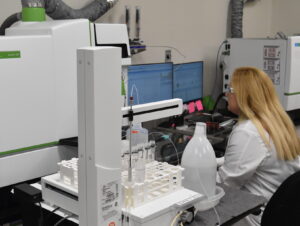The MCLinc laboratory facility is equipped with an array of spectroscopy techniques including UV, UV/Vis, FTIR, ICP-OES, and ICP-MS.
 Fourier transform infrared spectroscopy (FTIR)
Fourier transform infrared spectroscopy (FTIR)
By monitoring the absorbance of the range of wavelengths or frequencies of an infrared light as it is transmitted through or reflected from (IR reflectance) a sample, a characteristic infrared spectrum can be obtained. Sensitivity allows for analysis of elemental concentrations in the ppm to ppb range and/or to surface regimes on the order of 1-10 atomic layers. Typical applications include:
-
-
-
-
- Identification of extractable organic components from a device or wafer surface or PWB
- Identification of contamination (oils, polymers, solvents, fluxes, greases, etc.)
- Identification of unknown solid organic compounds (powders or residues and solvent or liquid organic)
-
-
-
Inductively Coupled Plasma Spectroscopy (ICP-OES)
Inductively Coupled Plasma Spectroscopy is used for highly accurate analysis of major and minor constituents in a wide range of materials. Plasma emission spectroscopy (OES) involved introducing a sample solution into the core of high temperature inductively coupled argon plasma (ICP). At temperatures near 8,000 °C, the thermally excited elements emit light at characteristic wavelengths, which is detected by a spectrometer. The light is diffracted, amplified, and analyzed to identify and quantify elemental concentrations in the sample.
Inductively Coupled Plasma Mass Spectrometry (ICP-MS)
Inductively Coupled Plasma Mass Spectrometry or ICP-MS is an analytical technique used for elemental determinations. When paired with plasma mass spectroscopy (MS), inductively coupled argon plasma (ICP) is used to generate ions, which are then introduced to the mass analyzer. These ions are then separated and collected according to their mass to charge ratios. The elemental concentrations in the sample are then identified and quantified.
